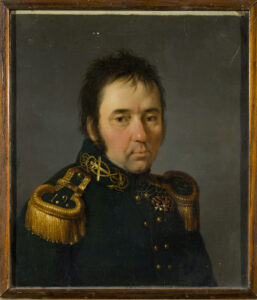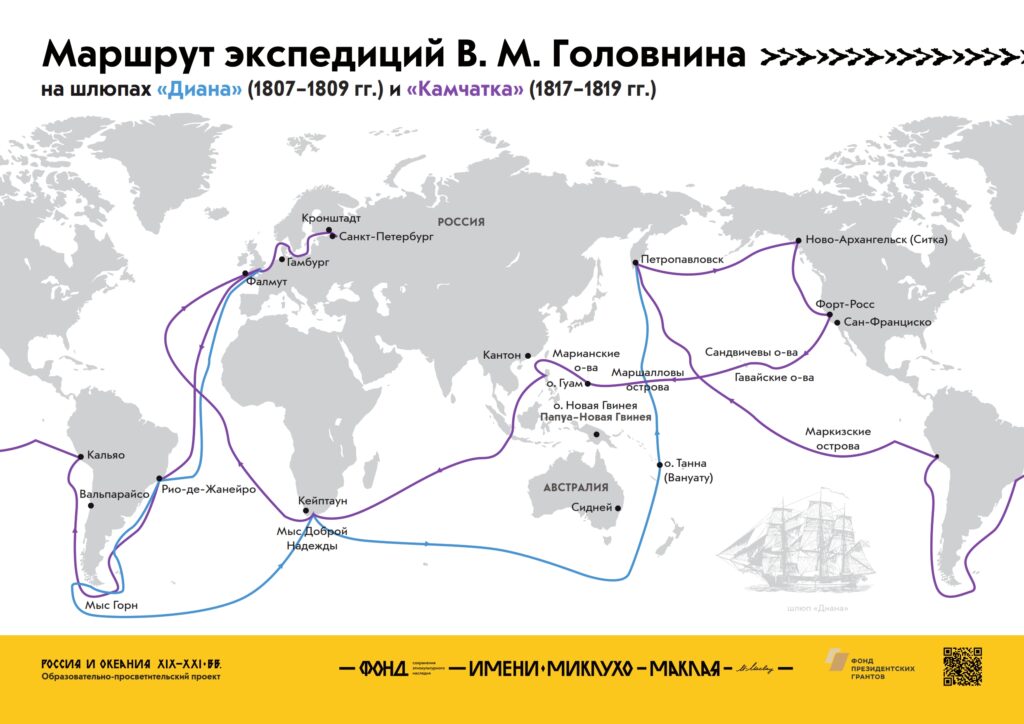Expeditions of Vasily Mikhailovich Golovnin on the sloops "Diana" (1807-1809) and "Kamchatka" (1817-1819)
During the first voyage in 1807-1809 on the sloop "Diana" V. M. Golovnin visited the island of Tanna in the southern part of Vanuatu (Melanesia), where he collected information about the life and culture of the local residents. During the second voyage in 1817-1819, on the sloop "Kamchatka" the traveler visited Hawaii and the Mariana Islands. Golovnin specified the location of Guam (in the southern Mariana Islands) and gave a detailed description of the Kingdom of Hawaii of King Kamehameha I.
An outstanding Russian navigator and talented scientist, Vasily Mikhailovich Golovnin made two circumnavigations that enriched world science and culture: on the sloops "Diana" and "Kamchatka". The first one took place in 1807-1809, when the explorer was 31 years old, the second - exactly ten years later, in 1817-1819.
The aim of the 1807-1809 around-the-world voyage was to deliver naval and military supplies and food to Russian America (the names given to remote Russian possessions in Alaska, the Aleutian Islands, the Pacific coast of North America, etc.) and to carry out scientific work, which included a description of the Kuril Islands.
The sloop "Diana" of the first expedition by Golovnin was originally built as a lumber carrier, then it was converted into a warship of 300 tons displacement with 16 cannons. It went down in history as the first ship of Russian construction to sail from the Baltic to Kamchatka. The route of the voyage, which began in Kronstadt on 25 July 1807, led through the Atlantic Ocean to Brazilian St. Catherine Island and on to Cape Horn, which failed to pass due to bad weather. Golovnin decided to take the eastern route to Kamchatka and turned to the Cape of Good Hope in South Africa, planning to replenish supplies at Simon's town, then owned by Great Britain. The British war fleet was based here, and a Russian ship called at this port for the first time in history. But due to the outbreak of war between Russia and England, the ship was captured by the British.
While being in the inevitable downtime, in August 1808, Golovnin became the first Russian to see and describe the New Zealand Maori, the son of the paramount chief of northern New Zealand returning home from England, where he was introduced to King George III.
A year later, on 16 May 1809, the seafarer managed to free his ship with a daring escape that sparked much discussion in the world press. Having escaped from Simon's Town, "Diana" made a 69-day non-stop passage from the Cape of Good Hope to Tanna Island in the New Hebrides archipelago (now a part of the state of Vanuatu) in Melanesia, in the South Pacific, and from there, just five days later, it sailed again non-stop to Petropavlovsk-Kamchatsky. After escaping, Golovnin, fearing pursuit, decided to stop at Tanna Island to replenish supplies of fresh water and provisions, as this location was as far from the usual sea routes as possible. European explorers had only visited the Island twice: English captain James Cook 35 years before Golovnin's expedition and Spaniard Pedro Fernandes de Queirós was the first to see the island 70 years before Cook. In describing Tanna in detail, V. M. Golovnin mentioned the "fire-breathing mountain", an active volcano called Yasur, which is clearly visible from the sea and today is the main tourist attraction on the island. The explorer also witnessed a small eruption of the volcano before setting sail off.
At the first meet with the locals there was a barter on the boats: iron items and beads were exchanged for food supplies. The islanders were quite friendly, despite the spears in their hands. It turned out that they were well aware of the purpose of the cannons aboard the ship from their encounter with Captain Cook and were afraid of them. However, the islanders developed such a trusting relationship with the Russian navigators that they cried when parting.
During his stay on Tanna Golovnin made a lot of valuable observations and collected a lot of ethnographic material on everyday life, customs, material culture of local people. It was not without curiosities: having set his foot on the shore for the first time, the navigator tried to explain in signs to the local Chief that he came from a vast country called Russia and that his ship was called "Diana". The Chief understood him as best as he could, and for the rest of Golovnin's stay on Tanna he was called Diana. "Maybe they remember me by this name," the traveler ironically wrote in his work "The voyage of the sloop "Diana" from Kronstadt to Kamchatka, made under the command of the fleet of Lieutenant Golovnin in 1807, 1808 and 1809". Interesting observations of the researcher are that the inhabitants of Tanna, the Melanesians, representatives of one of the oldest Stone Age cultures on earth, differed greatly from the Polynesians in the level of material development.
As the pigs and chickens, a valuable source of protein for the ship's crew, were not obtained from the islanders in sufficient quantity, and the water was not running, but standing and quickly went bad, Golovnin concluded that the place was completely unsuitable for resupply and that seafarers should not venture here in the future.
The expedition team brought cultural and everyday life objects from Tanna Island to Saint-Petersburg. This ethnographic collection of V. M. Golovnin was given to the Peter the Great Museum of Anthropology and Ethnography (the Kunstkamera) in 1819.
On 28 July 2009, in Port Vila, the capital of Vanuatu, by the initiative of the local "N. Mishutushkin - A. Pilioko Foundation Art Gallery" and the Russian Government a bust of V. M. Golovnin was unveiled to mark 200 years since the first stay of Russians on the island of Tanna.
Leaving the island on 31 July 1809, "Diana" set sail for Kamchatka, arriving on 23 September the same year.
In 1810 the ship sailed to Kodiak Island, delivering bread from Kamchatka. Golovnin collected valuable information about the state of the Russian-American Company. During an observation of the Kuril and Shantar Islands, and the Tatar Strait, on Kunashir Island, a part of the Kuril group, the ship and its crew were taken prisoner by the Japanese. Golovnin was released from captivity two years later, in 1813, and reached Saint-Petersburg through Siberia in 1814.
During the expedition cartographic research was carried out, the correct geographical names were clarified and the climate of the Kuril Islands was observed. Thanks to the 1st expedition of V. M. Golovnin, valuable and systematized materials on the peoples of the Pacific have come down to us.
The second around-the-world expedition of the navigator took place at the expense of the Russian Government in 1817-1819 on a specially built military sloop "Kamchatka" with a displacement of 900 tons and 32 cannons. Its aims were to deliver supplies and food to Petropavlovsk-Kamchatsky and Okhotsk (the main port city for Russian-American Company ships); to make an observation of the northwest coasts of North America and astronomically determine a number of points in Russian possessions; to correct maps; and to study relations between employees of the Russian-American Company and the local inhabitants.
Leaving Kronstadt on 26 August 1817, "Kamchatka" sailed to Rio de Janeiro, rounded Cape Horn, called at the port of Callao near Lima, the capital of Peru on the west coast of South America, delivered supplies to Kamchatka, visited the Aleutian Islands and Kodiak Island, the first capital of Russian America, called at Novo-Arkhangelsk, the second capital of Russian America (now Sitka, Alaska). It visited Fort Ross on the northwest coast of America (a Russian settlement in the area of present-day San Francisco that existed in 1812-1841), Monterey and Rumyantsev Bay (now Bodega Bay). From there it set sail for the Sandwich Islands (now Hawaii), then on to the Mariana Islands visiting Guam, then on to Manila (capital of the Philippines), then through the English island of St. Helena (the place of exile of Napoleon in 1815-1821) and the Portuguese islands of Azores on to Kronstadt.
From the coast of North America Golovnin headed for the Hawaiian Islands, where the expedition arrived on 19 October 1818, and stayed for 12 days. Thanks to the explorer valuable information about the culture, traditions, economy and history of the islands has come down to us. Golovnin was introduced to Hawaii by an aide to Kamehameha I, King of Hawaii, John Eliot de Castro, a man of Anglo-Portuguese origin who had been in close contact with Russian captain Otto von Kotzebue during his stay on the island two years before, in 1816. The traveller's attention was also drawn to the fact that all the locals, including Eliot, strictly adhered to standing prohibitions - taboos, which related, for example, to the norms of behavior when men and women ate.
Golovnin then visited the site of James Cook's murder; a description of the events was given in detail by Eliot, who learned of them from King Kamehameha I, who in turn witnessed the incident first-hand.
The explorer personally met the King of the Kingdom of Hawaii, Kamehameha I, of whom the captain has the best impression: he is "vigorous, strong and active, temperate and sober, never drinking strong drinks and eating very moderately. In him one can see a striking mix of childish deeds and the most mature judgments and acts, which would not have dishonored a European ruler. His honesty and love of justice may show his various actions in their present form".
On 30 October 1818, "Kamchatka" headed for the Mariana Islands. Before sailing off, Golovnin took on the service a young, nimble native Hawaiian, aged 25, named Lauri, believing that he, having learned Russian, would be of great help to the Russian-American Company in its trade with Hawaii. After arriving in Kamchatka and then visiting Saint-Petersburg, where he spent the winter, Lauri sailed home to Hawaii. On his return home Lauri was very popular (including at the court of the Hawaiian King) as a storyteller about the wonderful northern country of Russia.
After visiting the Hawaiian Islands, the sloop "Kamchatka" headed for Guam in the Mariana Archipelago to replenish supplies. V. M. Golovnin clarified its position (it turned out to be 58 miles to the west of what British cartographers thought).
A met with the Governor of Guam took place at Umatac Bay, the same place where Guam was discovered in 1521 by the Portuguese explorer Ferdinand Magellan during his circumnavigation and where the conquistador Miguel López de Legazpi declared the island property of the Spanish Crown in 1565.
On Guam he managed to stock up on plenty of supplies, including chickens and pigs. The abundance of good food amazed Golovnin at the general poverty of the island. No one traded with Guam: for export, the occasional ships to Guam were offered only fighting roosters, highly prized in Manila (capital of the Philippines). "Kamchatka" left the island five days later, on 26 November 1818, and headed for Manila, thence to St. Helena Island and through the Azores to Kronstadt where it anchored on 5 September 1819.
The research carried out by Golovnin during his voyages made a huge contribution to geographical science. The maps and descriptions made by him during the expeditions are distinguished by great accuracy and detail. He drew valuable conclusions about the laws and directions of the wind, its strength and influence on the weather. In 1873, the Naval Office published a book entitled "Meteorological observations made during around-the-world voyage of the sloop "Kamchatka" commanded by Captain 2nd Rank Golovnin in 1817, 1818, 1819".
Литература
Головнин В. М. Сочинения. М.; Л., 1949.
Океанские походы шлюпа «Диана» // Военное обозрение. 20 июня 2017. https://topwar.ru/118351-okeanskie-pohody-shlyupa-diana.html
Памятник вице-адмиралу В. М. Головнину открыт на Вануату // Единение. 08.08.2009. https://www.unification.com.au/news/141/
Путешествие вокруг света, совершенное на военном шлюпе «Камчатка» в 1817, 1818 и 1819 годах флота капитаном Головниным. М.; Л., 1949. http://az.lib.ru/g/golownin_w_m/text_0020.shtml
Путешествие шлюпа «Диана» из Кронштадта в Камчатку, совершенное под начальством флота лейтенанта Головнина в 1807, 1808 и 1809 годах. М.; Л., 1949. http://az.lib.ru/g/golownin_w_m/text_0050.shtml
ЮАР. Саймонстаун. Русские моряки. Официальный сайт путешественника Юрия Волкова. http://worldsall.ru/yuar-sajmonstaun-russkie-moryaki/




